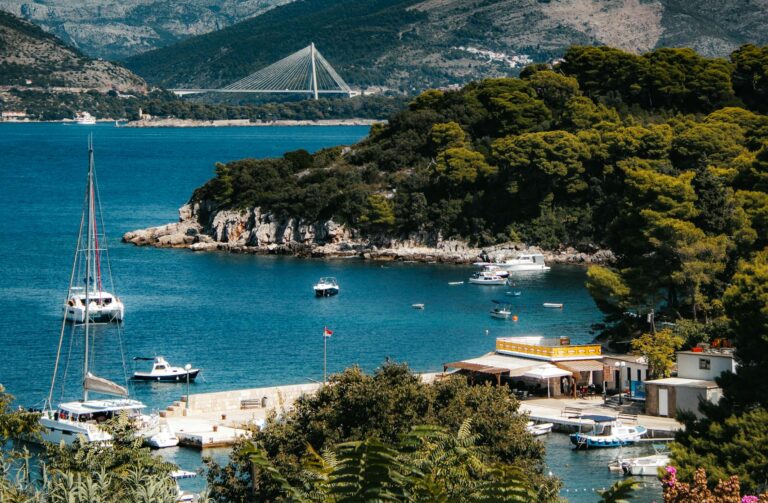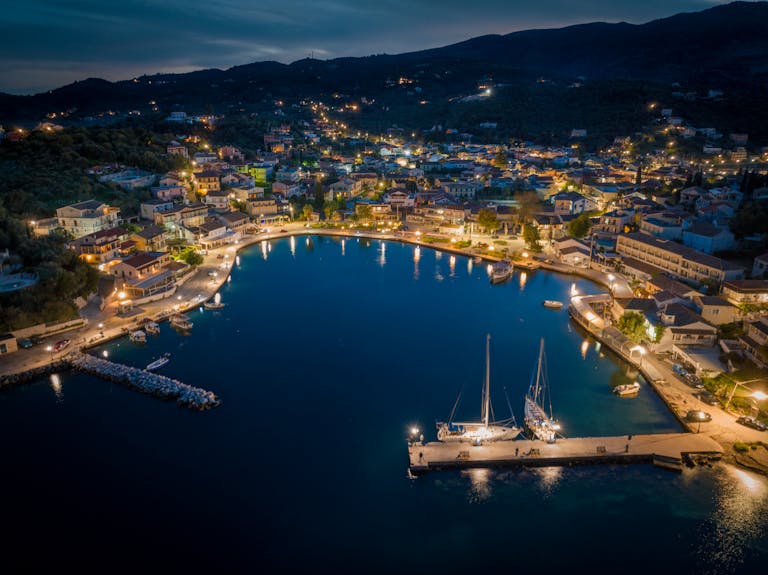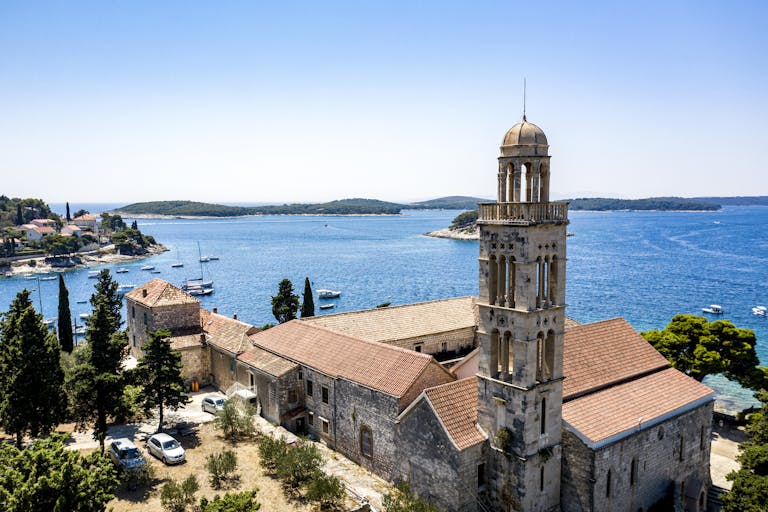Sailing in Greece
Sailing in Greece offers a captivating blend of reliable winds, diverse island groups, and rich maritime traditions. Whether you’re a novice sailor charting Greek waters for the first time or an experienced skipper expanding your adventures, understanding the local conditions and customs is essential for safe and enjoyable sailing in Greece. This guide breaks down everything you need to know – from seasonal winds like the Meltemi and local climate, to the quirks of each island region, harbour know-how, regulations, and charter tips.
1. Winds and Climate for Sailing in Greece
1.1 The Meltemi and Its Impact
Greece’s conditions for sailing in Greece are heavily influenced by its winds and Mediterranean climate. In summer, the most famous wind is the Meltemi – a strong, dry northerly wind that blows across the Aegean Sea. Known since ancient times as the Etesian winds, the Meltemi originates from high-pressure systems over the Balkans and low pressure over Turkey¹. It typically blows from the north or north‐east, peaking in strength during July and August, and provides welcome relief from the heat. On a typical day the Meltemi starts as a light breeze in the morning and builds to force 4–5 Beaufort (11–21 knots) by afternoon, often dying down overnight¹. However, during peak summer it can reach force 7–8 (near 30+ knots) and persist for days on end, at times even halting ferry services¹. Such continuous high winds can be exhilarating but also challenging for small yachts, so planning your sailing in Greece itinerary around the Meltemi is crucial.
1.2 Understanding Katabatic Winds
Katabatic winds are another phenomenon to be aware of when planning sailing in Greece. Due to Greece’s mountainous terrain, when the land cools at night or when strong winds hit high islands, cold, dense air rushes downhill. This creates sudden gusts on the leeward side of mountains (often called fall winds). For example, the Meltemi’s katabatic effect may cause fierce down-slope gusts on the south side of high islands such as Evia, Tinos, or Amorgos². A telltale warning is the appearance of an orographic cloud hanging over a ridge – if you see a stationary cap of cloud on a mountain, expect strong gusts on the downwind side². Always secure your sails and anchor accordingly, and be prepared for sudden winds even on clear days when sailing in Greece.
1.3 The Anemoi and Other Local Winds
The Anemoi refer to the ancient Greek wind gods, whose legacy survives in the names of modern winds. The four chief Anemoi were Boreas (North), Zephyrus (West), Notus (South) and Eurus (East)¹. In modern Greek, anemos means wind, and many local winds echo these classical names. For instance, the Meltemi is essentially a summer manifestation of Boreas, bringing dry northern air. The Maestro (or Maestral) is a northwesterly afternoon breeze named after Zephyrus and prevails in the Ionian Sea and Adriatic during summer¹. Meanwhile, Notos (South Wind) often appears in winter, and Sirocco (called Sorokos in Greek) is a south‐east wind that occasionally blows in spring or autumn, carrying warm, humid air and Saharan dust¹. Though Sirocco events are infrequent in the summer high season, they can prompt many sailors to stay in port until conditions improve¹.
1.4 Seasonal Climate Overview
Greece exhibits a classic Mediterranean pattern, crucial for sailing in Greece. Summers (June–August) are hot and dry with reliably clear skies and steady winds – ideal for extended cruising. The Meltemi is most prevalent from late June to early September, with July–August as its peak¹. In spring (April–May) and autumn (September–October), the weather is milder, with lighter, more variable winds; these shoulder months are ideal for those who prefer gentler conditions and fewer crowds³. Winter sailing (November–March) is generally for the most experienced, as storms and sporadic gales replace the predictable summer winds.
2. Geographical Influence: Squalls and Local Weather
2.1 How Squalls Affect Sailing in Greece
Greece’s fragmented landscape of islands, peninsulas, and mountains creates many local weather effects that impact sailing in Greece. One moment you may be sheltered in the lee of an island with gentle breezes, and the next you might encounter a fierce gust or squall as you round a headland.
A squall is a sudden, sharp increase in wind speed, often accompanied by rain or thunderstorms. Squalls may arise from convective weather (thunderclouds) or from wind funneling and shear near mountains. In sailing in Greece, thunderstorm-driven squalls are more common in the Ionian and during early or late seasons, while wind-funnel or katabatic squalls can occur at any time due to the terrain².
2.2 Regional Squall Dynamics
- Ionian Sea: Humid and unstable air can lead to afternoon cloud build-up over the mainland or larger islands. These clouds may develop into brief thunderstorms with heavy rain and gusty winds. If you see towering cumulus clouds or a dark line of cloud on the horizon, assume a squall could hit—reduce sail in advance and adjust course accordingly.
- Aegean Sea: Rain squalls are rarer in summer under Meltemi conditions; however, the complex island topography often produces wind surprises through funneling. For example, a gap between Andros and Evia can accelerate the northerly Meltemi to unexpected speeds, generating large, steep waves over open water.
- Local Gusts and Eddies: Lee-side gusts and eddies created by high islands can cause sudden gale-force bursts on the downwind side. Always be vigilant and ready to reef your sails when sailing in Greece.
Good seamanship is essential to mitigate the risks of squalls. Always check forecasts and observe the sky. If a severe squall is forecast or visible on the horizon, consider altering course to find shelter or postponing departure. Should winds suddenly increase or shift, reduce sail area immediately and secure all loose items on deck².
3. Key Regions for Sailing in Greece
Sailing in Greece encompasses several distinct regions, each with its own character, challenges, and attractions. The primary areas most sailors explore include the Ionian Islands, the Saronic Gulf, the Cyclades, the Dodecanese, and the Sporades.
3.1 Ionian Islands – Ideal for Beginners
The Ionian Islands – including Corfu, Paxos, Lefkada, Kefalonia, Ithaca, and Zakynthos – are often considered the most beginner-friendly area for sailing in Greece. These islands are lush and green, with a gentler climate than the Aegean. Calm waters and mild winds (often the northwesterly Maestro) make for relaxed sailing, ideal for new sailors and families⁴. With distances of 10–30 nautical miles between major islands, the Ionian offers line-of-sight navigation and plenty of sheltered bays.
3.2 Saronic Gulf and Eastern Peloponnese – For Intermediate Sailors
The Saronic Gulf, immediately south-west of Athens, includes islands such as Aegina, Poros, Hydra, and Spetses, along with the eastern Peloponnesian coast. This region offers gentler winds and easier conditions for sailing in Greece than the open Aegean, thanks to its proximity to the mainland and a diluted Meltemi effect⁵. It is an ideal stepping-stone for intermediate sailors looking to venture beyond the Ionian without facing the full fury of the Meltemi.
3.3 Cyclades Islands – A Challenge for the Experienced
The Cyclades, home to iconic islands such as Santorini, Mykonos, Paros, and Naxos, are the postcard image of sailing in Greece. Their breathtaking scenery comes at a price: during summer, the Meltemi funnels through the Cyclades at full strength, with winds often reaching force 6–7 (25+ knots)⁴. Open-water crossings between islands can be 20–40 nautical miles, and natural harbours may be limited. For this reason, the Cyclades are best suited for experienced sailors or skippered charters. However, in May, June, or September, conditions may be more forgiving for those with some experience.
3.4 Dodecanese Islands – A Mix of Adventure and Comfort
The Dodecanese, running along the Turkish coast, include Rhodes, Kos, Patmos, Leros, Symi, and others. This region experiences a mix of Aegean conditions: while it feels the Meltemi in summer, its winds can be slightly less intense than in the Cyclades due to its geographical position. Generally, the Dodecanese is suitable for intermediate to experienced sailors, with well-equipped harbours and the possibility of mixed-nation cruising when visiting nearby Turkey².
3.5 Sporades and Northern Aegean – Quiet and Unspoilt
The Sporades – notably the Northern Sporades including Skiathos, Skopelos, Alonissos, and Skyros – are less frequented and offer quieter, unspoilt conditions for sailing in Greece. The sheltered gulf of Volos, for instance, provides calm, almost lake-like conditions ideal for beginners. Although the prevailing summer wind is the Meltemi, it is often weaker here, making the Sporades an excellent choice for relaxed cruising while still offering the beauty of the Aegean⁹.
4. Harbours and Mooring Techniques for Sailing in Greece
4.1 Major Charter Bases and Marinas
When chartering for sailing in Greece, you will typically start and finish at a well-equipped marina. In the Ionian, key bases include Gouvia Marina (Corfu), Lefkas Marina (Lefkada), and the marina at Zakynthos. In the Aegean, Alimos Marina near Athens is popular, while in the Dodecanese, marinas in Kos and Rhodes offer full services. In the Sporades, the town quay at Skiathos and the marina in Volos are common points of departure.
4.2 Town Quays and Mediterranean Mooring
In many small ports, boats are moored at town quays using traditional Mediterranean mooring techniques. This involves dropping your anchor a few boat-lengths from the quay, manoeuvring stern-to the dock, and securing stern lines to bollards or rings. Mastery of med mooring is crucial for sailing in Greece, as it allows multiple boats to berth closely together⁶.
4.3 Anchoring in Secluded Bays
Greece offers many secluded bays ideal for overnight anchorage. When anchoring, ensure you have adequate scope (typically a 3:1 ratio) and, where possible, use a long line ashore to reduce swing. This technique is particularly useful in the narrow coves common throughout the islands.
5. Codes of Conduct and Regulations for Sailing in Greece
5.1 Licensing, Documentation and Legal Requirements
For bareboat charters, Greek authorities require that at least one person on board holds a valid sailing licence (usually an ICC or equivalent such as the RYA Day Skipper)⁷. Always carry your passport, boat registration documents, and, if applicable, a VHF radio licence. Compliance with these requirements is essential when sailing in Greece.
5.2 Right of Way, Colregs and Environmental Standards
Standard international collision regulations (Colregs) apply in Greek waters. Always yield to power-driven vessels, especially large ferries and commercial traffic, and maintain a vigilant watch. Protecting the pristine marine environment is paramount when sailing in Greece; discharging sewage or litter into the sea is strictly prohibited.
5.3 Harbour Etiquette and Local Customs
Greek harbour culture is rooted in courtesy and cooperation. When mooring at a town quay, be prepared to help fellow sailors and follow local customs—enhancing your overall experience of sailing in Greece. A friendly greeting (“Yassas”) and respectful behaviour go a long way.
6. Chartering in Greece: How It Works
6.1 Bareboat Charter Options
For those without their own boat, chartering is the primary way to experience sailing in Greece. In a bareboat charter, you rent a yacht and skipper it yourself with your own crew. You must meet legal requirements, including having a licensed skipper onboard⁷. The process involves paperwork, a technical briefing, and a pre-sail inspection. The boat is delivered fully equipped with fuel, water, and safety gear—allowing you to plan your own route for an authentic experience.
6.2 Skippered Charter Services
If you prefer a stress-free holiday or lack a licence, a skippered charter is ideal. Here, a professional skipper handles navigation and technical matters, allowing you to relax and enjoy sailing in Greece while learning from local experts. Skippered charters often include the skipper’s advice on planning itineraries and securing berths in busy harbours.
6.3 Flotilla Charter Advantages
Flotilla sailing is a popular option that blends independence with support. In a flotilla, each boat comes with its own professional skipper, so you can purchase a single place even if you have no sailing experience. The lead crew coordinates daily briefings, mooring arrangements, and group itineraries, ensuring that even novices can enjoy sailing in Greece safely while partaking in the social aspects of group sailing⁸.
6.4 Fully Crewed Charter Experiences
For a luxurious, private experience, fully crewed charters provide a captain, chef, and additional staff. This option allows you to enjoy every aspect of sailing in Greece without any rig labour.
6.5 Charter Costs and Booking Tips
Charter prices vary by boat size, type, and season. Peak season (July–August) is the most expensive, while shoulder months offer more affordable options. Always book well in advance when planning sailing in Greece.
7. Matching Regions to Skill Levels
7.1 Best Regions for Beginners
The Ionian Sea is ideal for beginners due to its tame winds, short distances, and forgiving conditions⁴. Flotilla charters in this area are particularly popular for new sailors embarking on sailing in Greece.
7.2 Ideal Areas for Intermediate Sailors
The Saronic Gulf and parts of the Dodecanese offer moderate winds and a balanced mix of lively ports and quiet bays, making them suitable for those with some experience—but not yet ready for the full fury of the Meltemi⁵ ³.
7.3 Regions for Advanced and Experienced Sailors
The Cyclades in peak summer, with strong Meltemi winds and longer open-water crossings, are best for experienced crews. Adventurous sailors may also explore remote areas in the north Aegean or challenge the Dodecanese during strong wind periods⁴.
Note: Docking skills are as crucial as sailing skills when sailing in Greece. If you lack confidence in close-quarters manoeuvring, consider a flotilla or skippered charter until you gain more experience.
8. Additional Tips for a Safe and Enjoyable Voyage
8.1 Provisioning, Fuel, and Water
Plan your provisioning according to your itinerary. Major ports such as Corfu, Lefkada, Athens, Kos, and Skiathos have large supermarkets, while remote islands may offer limited supplies. Always keep fuel topped up and monitor water levels—both are essential for uninterrupted sailing in Greece.
8.2 Navigation and Weather Planning
Use multiple navigation sources—electronic charts and paper guides—to navigate the often-complex waters of Greece. Check marine forecasts daily from reliable sources like the Hellenic National Meteorological Service. Monitoring Meltemi forecasts is vital, as even small changes can affect your course when sailing in Greece.
8.3 Communication and Safety Equipment
A Greek SIM card or an international plan is useful for staying connected during your voyage. Keep VHF Channel 16 active for emergencies, and ensure every crew member knows the location and operation of safety equipment. Regular drills, including man-overboard procedures, are essential.
8.4 Mastering Med Mooring Techniques
When med-mooring, always allow for a generous scope of anchor chain and use fenders to protect your boat. Practice these manoeuvres in calm conditions before venturing into busier harbours.
8.5 Embracing Local Customs
Finally, embrace the Greek island rhythm. A friendly greeting and willingness to help fellow sailors enhance the experience of sailing in Greece and contribute to a positive maritime culture.
References
- The Winds for Sailing in Greece
https://www.yacht-rent.com/greece/the-winds-in-greece#:~:text=in%20Greece%20is%20the%20seasonal%2C,most%20island%20ferries%20cannot%20sail - Meltemi Storms in the Aegean Sea of Turkey and Greece
https://sailingissues.com/meltemi.html#:~:text=Important%20guidelines - Guide to Sailing in the Dodecanese Islands – Viravira Blog
https://blog.viravira.co/guide-to-sailing-in-the-dodecanese-islands#:~:text=Choosing%20the%20right%20time%20to,bustling%20ports%20and%20crowded%20attractions - Sailing the Greek Islands: Everything You Need to Know – Insight Vacations
https://www.insightvacations.com/blog/sailing-the-greek-islands/#:~:text=When%20looking%20at%20sailing%20the,better%20suited%20for%20seasoned%20sailors - Weather Conditions for Sailing in the Saronic Gulf
https://www.catamaran-charter-greece.com/blog/weather-conditions-for-sailing-in-the-saronic-gulf/#:~:text=Weather%20Conditions%20for%20Sailing%20in,the%20afternoon%2C%20which%20is - Mediterranean Mooring: What Is It and Why? – ASA News
https://asa.com/news/2023/01/10/mediterranean-mooring-what-is-it-and-why/#:~:text=The%20Mediterranean%20Moor%20is%20a,fit%20in%20a%20small%20place - Sailing Licence Requirements in Greece – Europe Yachts Charter
https://europe-yachts.com/blog/sailing-license-requirements-in-greece-according-to-europe-yachts-charter/#:~:text=In%20order%20to%20sail%20in,you%20will%20need%20to%20have - Flotilla Sailing | Sunsail
https://www.sunsail.com/au/sailing-holidays/flotilla-sailing#:~:text=Explore%20some%20of%20the%20world%E2%80%99s,hire%20a%C2%A0skipper%20for%20your%20adventure - Volos – A Portrait of the Beginner-Friendly Sailing Area in Greece! – Bavaria Yachts
https://www.bavariayachts.com/we-are-bavaria/stories/volos-a-wonderful-sailingarea-in-greece/#:~:text=The%20sailing%20area%20around%20Volos,plays%20a%20role%2C%20of%20course






